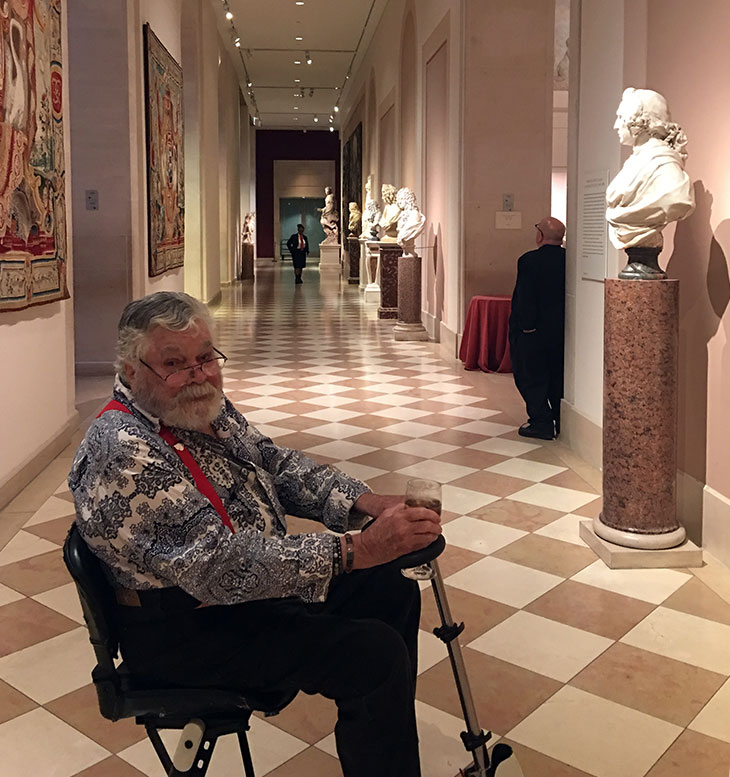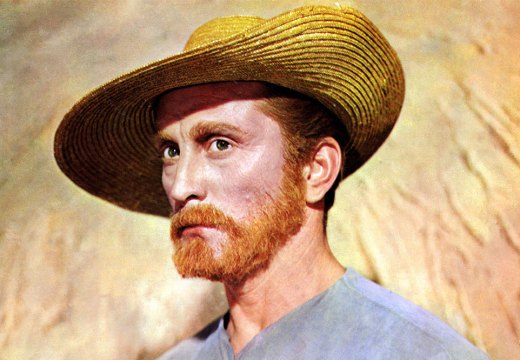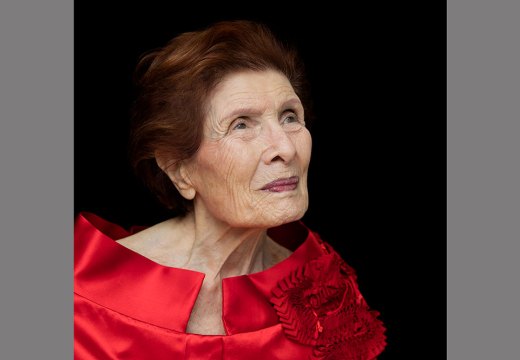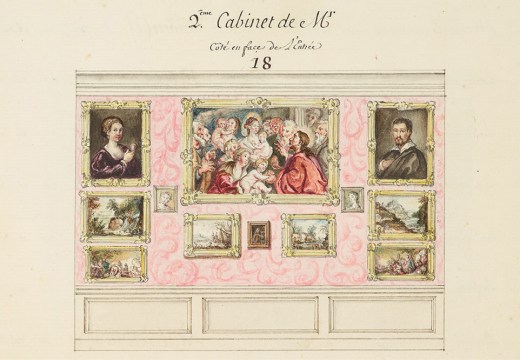For many years Reader’s Digest ran a popular series of biographical sketches under the heading of ‘The Most Unforgettable Character I Ever Met’. I am certain that Michael Hall – the collector, art dealer and former actor who died last month at his home in Miami Beach at the age of 93, survived by his husband Thomas Malmberg – filled that role for most of his numerous friends and acquaintances. He retained from his early days in Hollywood the ability to command the immediate attention of every person in any room he entered. And he had an endlessly entertaining repertory of anecdotes and jokes that he could recite so well that no one who had heard him could retell them except by repeating Michael’s own words. There was no way to improve upon him, even if one wondered how much of the stories’ content was his own embellishment.
Most of his friends in the art world came to know him after he had given up his youthful career as an actor, most notably playing the son of Fredric March’s Sergeant Al Stephenson in The Best Years of Our Lives, William Wyler’s masterpiece of 1946. I always wondered why his character dropped out of the story too early, before several scenes in which he logically should have appeared. Michael explained that his contract had ended while the film was still being shot, and the producer, the legendary Samuel Goldwyn, refused to pay anything extra to rehire him. Michael retained a number of glamorous friends from those years, most notably Paulette Goddard (the on-screen foil and one-time wife of Charlie Chaplin) and her husband, the novelist Erich Maria Remarque, and the thespian couple Charles Laughton and Elsa Lanchester. A friendship with Marion Davies granted Hall access to objects in the vast collection of her lover William Randolph Hearst as it was being dissolved. The spoils included several important early Chinese stone sculptures and the purported marriage bed of the 16th-century Florentine noblewoman Maria Salviati, on which Hall subsequently slept for many years. Hearst’s acquisitive obsession was immortalised in the character of Charles Foster Kane in Citizen Kane – Michael knew Orson Welles and claimed to have coached him in a German accent. He loved the company of personalities as large as his own, and later in life he became a close friend and travel companion of the heiress Doris Duke.
He began collecting art early on, but his real training came subsequently from two great connoisseurs. He could not have selected better mentors: in Los Angeles in the 1950s, Wilhelm Valentiner, then the consulting director of what was to become the Los Angeles County Museum of Art and previously the director of the Detroit Institute of Arts; and in London the following decade, John Pope-Hennessy, then the keeper of sculpture at the Victoria and Albert Museum (until 1967, when he was appointed director). He also became the lifelong friend of leading authorities in his chosen field, including such luminaries as Rudolf Wittkower, H.W. Janson, and Francis Watson. Not surprisingly, Michael became a particular expert in the connoisseurship of Renaissance and mannerist sculpture, although as a dealer and especially as a collector, his tastes were amazingly catholic, covering virtually all periods, media and parts of the world. Though this included paintings and graphic arts, Michael was drawn above all to the three-dimensional: sculpture (the great and the small, including comprehensive assemblages of Renaissance bronze statuettes, lamps, inkwells, animal life-casts, medals and plaquettes), objets d’art, and furniture, all works that engage the body and touch as well as the eyes.

Michael Hall. Courtesy Thomas Malmberg
Michael delighted in being outrageous, but he could also be infinitely charming when he chose. I remember years ago in Venice when – in his beautifully enunciated but elementary Italian – he convinced the sacristan of the church of San Moisè to let him and Bill Mills, his gallery partner and another former actor, clean a dusty 17th-century bronze altar by Nicolò Roccatagliata. I can only imagine the Venetian soprintendente’s shock when he eventually discovered Michael’s handiwork – the work was more recently restored professionally by the Fondazione Venetian Heritage – but for Michael, it really was a labour of love.
He ran his gallery from a series of progressively larger apartments and townhouses that he occupied on the Upper East Side of Manhattan, each of them filled to bursting with his ever-growing collections. His overstuffed closets alone would have driven Marie Kondo to despair. A true child of the Great Depression, he had difficulty parting with anything he owned, a temperament that was often at odds with his profession as dealer. A typical room was the ‘Asian’ library of his former townhouse one block from the Metropolitan Museum of Art, where each shelf was chock-full of Buddhist sculpture in wood, stone, ceramic, and jade and every flat surface supported dozens of marble and terracotta busts by Jean-Antoine Houdon and his circle (Voltaire with and without a wig, and a masterful portrait capturing the pox-ravaged complexion of the composer Christoph Willibald Gluck). Over the mantle was a small oil sketch of John Singer Sargent’s El Jaleo, which hangs at the Isabella Stewart Gardner Museum in Boston – a museum whose rooms offer perhaps the closest analogy to Hall’s installations but are restrained by comparison. Yet unlike the Brahmin eclecticism of Gardner, Michael resisted the highbrow; his was a lived-in, and loved-in, collection. The entire floor of his library was generally covered with trays of crystals and beads, purchased by the sack during his weekend excursions to flea markets. From these, he would string necklaces to adorn his ancient Roman and Renaissance busts throughout the house. For Michael, there was no irony in gilding the lily. But somehow it all came together spectacularly.
Although he was a regular at Sotheby’s and Christie’s auctions, he made some of his most remarkable discoveries touring antique shops and flea markets in cities and in the countryside, wherever he found himself. Anyone who had seen him at the immense unshaded outdoor antiques market in Brimfield in central Massachusetts – where he returned faithfully for the three week-long bazaars each summer – patiently examining every work in every booth, would have wondered why he chose to rummage there for eight hours a day, rain or shine. And yet his dedication often paid off. It was in Brimfield that he found a large bronze version of Giambologna’s Mercury, recognising the early patina on what was being offered as a 19th-century cast. Among the numerous other major discoveries of his career were a bronze satyr by Tribolo, a spectacular bronze centaur attributed to Cellini, a stucco relief of the Virgin and Child by Donatello that he donated to the Yale University Art Gallery, and a terracotta bust of Christ by Verrocchio that was featured prominently in the recent exhibition at the National Gallery of Art in D.C. and the Bargello.
Michael’s collections furnished a series of museum-quality exhibitions at the former Salander-O’Reilly galleries in New York in the late 1990s (before their legal problems): on Houdon, Giambologna, and ‘Masterpieces of Renaissance sculpture’. Two of these shows subsequently travelled to museum venues. Though Michael was reluctant to part with these works, the last show resulted in the celebrated acquisition of Johann Gregor van der Schardt’s self-portrait – among the earliest independent self-portraits in sculpture – by the Rijksmuseum. An exhibition from his collection of images of Christ and Mary across media and eras originated at the Gallery at the American Bible Society in New York and travelled nationwide. The most recent exhibition of his works, showing French Renaissance graphic art and sculptures, was ‘Le Goût du Prince: Art and Prestige in Sixteenth-Century France’ at the Yale University Art Gallery in 2016. Michael was particularly pleased that undergraduates organised the show as part of a hands-on seminar course.
Indeed, Michael was a generous and gifted teacher in his area of expertise and was often invited by his mentors and curator friends to hold sessions on connoisseurship. Among the graduate student assistants at his gallery in New York were two future directors of the Frick Collection, Anne Poulet and Ian Wardropper.
Remarkably well-read and informed on all subjects that interested him, Michael had the genuine connoisseur’s eye and astonishing visual memory that were the hallmarks of art historians of earlier periods. I remember so well his returning from a flea market in Connecticut with a beautiful though faded embroidered silk coin purse that, as he explained, would have been carried by a French nobleman in the 16th century. Once he pointed out what the unusual object was, it was clear that he was right, and yet who but Michael could have identified such a treasure in the cluttered stall of a country antiques dealer?
Unlimited access from just $16 every 3 months
Subscribe to get unlimited and exclusive access to the top art stories, interviews and exhibition reviews.














![Masterpiece [Re]discovery 2022. Photo: Ben Fisher Photography, courtesy of Masterpiece London](http://www.apollo-magazine.com/wp-content/uploads/2022/07/MPL2022_4263.jpg)
It’s time for the government of London to return to its rightful home